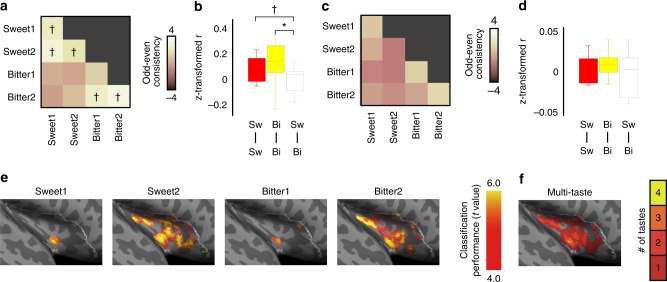Fig. 4.
Specificity of taste quality not chemical compound in the insula under super-high field strength. a Correlations of voxel activation between odd and even runs between all taste combinations within each participant, submitted to one-sample t-test across participants (n = 11 participants). Statistically significant correlations within taste types but not across taste types suggest voxel-specific tuning at the individual level. b Correlations between odd and even runs for each same taste and different taste combinations in a show within-taste-type correspondence. Boxes represent the median and 25th/75th percentiles and whiskers represent the minimum and maximum. c The same correlations in a computed for voxels defined by group-level sensitivity to taste stimuli for each subject in a leave-one-out procedure. One-sample t-test across participants showed no taste specificity at the group level. d Correlations between odd and even runs for each same taste and different taste combinations in c reiterate lack of group-level taste specificity. Boxes represent the median and 25th/75th percentiles and whiskers represent the minimum and maximum. e Multivoxel pattern analysis shows group-level discriminability maps for sweet 1, sweet 2, bitter 1, and bitter 2 stimuli. f The number of taste stimuli represented in the insula. This replicates multi-taste population codes representing and discriminating multiple tastes in the anterior/middle insula as is shown in Fig. 2b. ✝p < 0.05 uncorrected, *p < 0.05 after Bonferroni correction for multiple comparisons (FWE < 5%)

